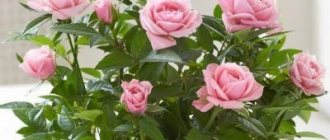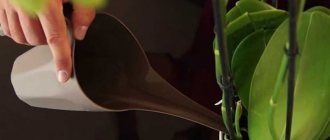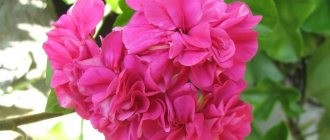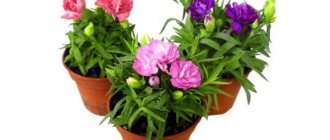Winter-hardy varieties of climbing roses
Nature has created amazing plants, and people strive to surround themselves with this splendor. And also comes up with new unusually beautiful variations. One of the most fascinating flowers is roses. Climbing roses that bloom all summer, winter-hardy varieties are perfect for growing near various supports, fences and arches. On the one hand, they resemble wild rose hips, and on the other, amazing specimens obtained after great effort, which attract not only their appearance, but also the pleasant aroma that fills the space around them.
Most of the varieties are represented by modern large-flowered roses. Flowering occurs in waves, and for some varieties it is almost continuous. They can reach two to three meters in height. Flowers cascade delicately from arches or arbors, creating a delightful view. They are perfect for transforming a backyard area, not only delighting the owner and others with their beauty, but also uplifting the mood. The buds have a wonderful aroma.
In order for roses to bloom for a long time, they require careful care. The plant will have to be tied up and directed in the right direction. Climbing roses that bloom all summer will be lush only if the requirements are met, then winter-hardy varieties will grow in comfortable conditions.
Important! For roses to be luxurious, they must be planted and cared for correctly.
A little history
Miniature roses owe their appearance to China. They were brought to Europe in 1810, but received widespread recognition only more than a century later.
In 1918 in Switzerland, Dr. Roulette rediscovered the beauty of this plant for Europeans. Having propagated one bush of a miniature rose, he, in fact, marked the beginning of its new history. It was from these specimens, which later received the name Roulette rose, that modern varieties of miniature roses originated. In Russia, collections of such flowers decorated the Imperial Botanical Garden.
Spanish and Dutch botanists began breeding new varieties only in 1940. Breeding scientists created new hybrids using other low-growing roses. Thanks to their work, a variety of varieties of miniature roses with bright colors and graceful flower shapes were obtained.
Classification of winter-hardy roses
In addition to the division into varieties and varieties, the division is also carried out into groups. The systematization is as follows:
- First group. True roses have elastic shoots in the shape of an arc. Grows up to 5 meters. The spines are beautiful and thin. The flowering is rich and lasts about a month in the first part of summer. The foliage is small. Representatives are winter-hardy.
- Second group. Created by mixing remontant, tea and hybrid tea roses. The plants are interesting with strong growth up to four meters. They turned out with voluminous flowers and are distinguished by their second flowering. Resistance to cold, partial resistance to disease.
- Third group. Created by changing bush roses with voluminous flowering. They develop rapidly and bear fruit a little later. Bright colors.
Dominique Loiseau
This delicate semi-double rose is named after the wife of a famous chef. Numerous snow-white flower cups densely dot the bushes, the height of which does not exceed 60 cm. At first, pink inclusions are noticeable on the inflorescences, which gradually lighten and become discolored. The rose is used as a scrub or ground cover; it is characterized by increased resistance to diseases and pests and at the same time maintains abundant flowering for a long period. The variety is also great for creating hedges and borders with contrasting color accents. Sometimes a rose of this variety is sold under the working name Delolia.
Climbing roses bloom all summer, winter-hardy varieties
There are two key characteristics by which the division occurs: small-flowered and large-flowered.
Roses with small flowers are called roses - Ramblers. Their difference is in thin and plastic shoots. They appear in early summer with small and primitive flowers. Flowering occurs once on last year's branches; this should be taken into account when pruning and covering.
Ramblers are quite unpretentious; they bloom all summer and are winter-hardy. These include:
- Bobby James. The best among small-flowered representatives. Up to eight meters in height, up to three meters in width. The foliage is green, but with abundant flowering it is practically invisible. Roses are creamy white, up to five centimeters. They emit a musky aroma. The variety is frost-resistant and disease resistant. Suitable for the Moscow region.
- Super Dorothy. Height up to 2.5 meters. The foliage is small. Late flowering, but rich and repeating. The variety is resistant to diseases, the flowers last until the onset of cold weather.
- Rambling Rector. It can reach more than seven meters in length. The color is pink, but gradually turns white. Roses are resistant to diseases and low light.
- Dortmund. Up to three meters long. The flowers are up to nine centimeters in size. The smell is not strong. Frost-resistant variety.
- Snow Goose. A sturdy and attractive creation. Height is more than three meters. The foliage is dark, with a small number of thorns. Flowers up to five centimeters, blooming all season almost uninterruptedly and abundantly. Resistance to diseases and frost.
Snow-Goose
The second group of Climings are climbing roses with strong, thick and hard shoots. Bred by crossing. Repeatedly, abundantly and for a long time blooming varieties on the shoots of the current year and previous years. The flowers are large and some have an intense aroma.
Claiming varieties:
- Michael (Orfeo). The buds have a chic dark color. The petals are velvety with a refined scent that becomes stronger in cool weather. The foliage is sparkling, dense, large. Resistant to diseases, but sensitive to rain. Flowering occurs continuously from June to October inclusive.
- Handel. The first re-blooming climber. With dark pink edging. The waviness of the flower adds sophistication. Inflorescences of 3-9 pieces are formed. Most beautiful when half-bloomed. Flowers are modified depending on weather conditions. Among roses, this variety has the most beautiful color contrast.
- Elf. Height up to 2.5 meters. Vigorous plant, large foliage. The flowers are greenish-white. Size up to fourteen centimeters. Fruity aroma. Resistant to rain and disease.
- Polka. A special rose. It is grown in two ways: as a low climber, or as a large, arched scrub. The buds are a concentrated apricot color, to creamy at the edges, the base is darker, which creates a play of colors. Flowering occurs repeatedly. Disease resistance. Variation in the appearance of roses depends on climatic conditions. It can reach three meters in height. The smell is not strong.
- Rimos. They have a colorful yellow color, turning lemon-colored in strong sun. Golden stamens are visible in the flower. Flowering is abundant and lasts until cold weather.
- Gloria Day Clyming. The flowers are yellow, not intense, with a pink edge. Up to 15 centimeters. The flowers have a weak, pleasant fruity aroma, solitary. Goblet shape. The plant can reach those meters. The foliage is dark and green. Flowering is medium, repeating. Winter-hardy.
- Golden Perfum. Rose with voluminous buds, twelve centimeters. Fragrant and rain resistant. They have a rich yellow color, enhanced by red stamens. The plant is branched, up to three meters. Flowering manages to repeat twice. This variety is one of the most famous among climbing roses. Flower in the shape of a cup. Flowers bloom slowly, making the owner happy for a long time.
- Parade. The variety is suitable for small-sized gardens. The flowers are large, concentrated pink or cherry red, cup-shaped, and the bushes are not particularly tall. Resistance to rain and frost is average. Rich repeat blooms.
- Schwanensee. A sought-after hardy variety, systematically flowering and resistant to rain. The flowers are voluminous, white with a slight pink tint. Looks great on a bush with bright green foliage. The buds have a standard appearance, elongated shape. The flowers open slowly. Diameter seven to eight centimeters. As a rule, there are no more than three of them per shoot. Flowers exude a delicate aroma. Flowering is long and repeated.
Varieties of semi-climbing cordes roses:
- Flamentanz. An actively blooming rose with a picturesque crimson color. Flowering occurs once, but can last up to thirty days. Diameter is about eight centimeters. Roses are found in inflorescences of three to sixteen pieces. Excellent winter hardiness is excellent for growing in Siberia. The plant is resistant to the most important diseases.
- Sympathy. Winter-hardy hybrid. Flowers with a tall glass, concentrated red color, with dark reflections. The first bloom is abundant, repeated blooms are weaker. The plant is resistant to rain, wind, and diseases. Up to four meters. The flowers are large and have a cup-shaped appearance.
- Westerland. The plant has strong disease resistance. The flowers are large, wavy. There are 5-10 pieces in brushes. Flowering begins early, but repeats itself. The foliage is elongated and dark. The bush is prickly. But the plant is beautiful.
Important! Regardless of the variety, any climbing roses require maximum attention, especially in the first year of cultivation.
The best varieties of climbing roses:
- Iceberg. One of the common types. The size of the flowers is up to eight centimeters. They bloom in inflorescences of three to eight pieces. The color is white, the aroma is subtle. Roses bloom all summer until late autumn. Excellent as a hedge.
- New Dawn. The size of the flowers is up to seven centimeters, in inflorescences of five to seven pieces. In rare cases, solitary. The color is soft pink, the aroma is not strong apple. Up to two meters high. Resistant to fungal diseases.
- Paul with Scarlett Clymer. Flowers up to seven centimeters. The color is concentrated red, the smell is slightly noticeable. Height is more than one and a half meters. Flowering occurs in the middle of the first summer month and lasts approximately for thirty days. After a short break, re-blooming begins. The plant is resistant to fungal diseases.
- Orange Morsdang. Low bushes, flowers up to five centimeters. Flowering is almost continuous. Does not tolerate rain well, has average resistance to diseases.
- Flamentanz. An unpretentious and winter-hardy rose. Rich flowering. Great resistance to diseases. In the first year the plant does not bloom.
There are many varieties. It is important to have an idea of their distinctive features, because this determines what the development needs will be and how to properly provide proper care, pruning, flowering, thorny or non-thorny plants.
During this time, the range of varietal roses has increased. Kordes are one of the best. They stand out for their special beauty and are characterized by abundant and long-lasting flowering. Excellent health and resistance to frost, easily overwinter.
Harkness are known everywhere. They are reliable in this they have no equal. Roses are unpretentious and easy to care for. Therefore, this is an ideal option for beginner gardeners. Repeated flowering, winter-hardy.
Roses from Tantau have appeared relatively recently. The plants are charming, bloom all summer, and tolerate rain well.
Climbing roses are in demand among gardeners. They have thin, long shoots that need support; they are irreplaceable for landscaping. Their sizes are not difficult to control and easily fit into different environments.
Kordes
Tantau
Avila Palace
A classic variety of floribunda roses. The flowers are light red or deep pink. This rose looks best as part of a border composition. However, it is also used for single planting, cutting or in rose gardens. The bushes reach a height of 1 m, they are resistant to various diseases. Flowering continues all summer, but only if the right place for planting has been chosen - sunny, protected from the prevailing winds. You will also need well-drained soil and timely removal of faded inflorescences.
Climbing roses planting and care in the Moscow region, the Urals, Siberia
Roses love light, and elevated southern locations suit them. Good lighting ensures rapid development of growth, and flowering can be expected next season. You cannot plant seedlings in lowlands; these flowers do not tolerate moisture well.
Know! When climbing roses serve to decorate an object, they should be planted half a meter away from it.
They should be planted in the spring, since in the fall they may not have time to adapt, and there is a high probability of their death. They do not have to allocate large areas; fifty centimeters is enough. The size of the holes is 50 x 50 cm. The prepared holes are watered before planting. After completing the process, the above-ground part must be cut to 15-20 cm. This is done for rapid growth and rich flowering in the future.
If you still choose autumn for planting, then this should be done at the end of September. Roses should have time to take root, but the buds should not begin to grow.
Next season, the plant no longer requires such careful and constant care. It is enough to trim the bushes in a timely manner, properly water and fertilize. Pruning is done to shape the bush and thin it out. Watering flowers should be once every seven to ten days. Organic matter, minerals and other fertilizers are suitable as fertilizers.
Plant plants at an angle of thirty degrees to the support. When planting near the house, it is necessary to maintain a distance from the wall so that running water does not fall on the roots. When tilted, the plant stays more stable in the ground. A rose near a wall may lack moisture.
Important! Climbing roses develop better in the sun; it is not recommended to plant them in the shade.
Review: Aelita seeds “Rose multiflorum Garden aroma” - From sowing to flowering!
Good day, dear readers! I think that there are very few people who are indifferent to the queen of flowers - the rose. I love this flower very much; in my garden there are more than 30 bushes of various roses. but I always dream of an indoor rose. Unfortunately, the indoor roses that I bought at the flower shop always quickly and inevitably die. I decided to grow miniature roses from seeds, because initially grown from seeds, they are better adapted to indoor keeping. I bought all kinds of seeds that were on sale. Today I will talk about the seeds of TM Aelita “Rose multiflora ever-blooming mini Garden aroma.”
On the back of the pack it is written that it can be grown in the garden and indoors, and brief recommendations on sowing and care are given.
I did not soak the seeds before sowing; I sowed them immediately dry from a bag. I took the soil based on coco soil and added a little perlite. The seeds were spread on the surface of the moist soil and sprinkled on top with a layer of about 5 mm. I covered the crops with film and placed them on the windowsill for germination. The seeds sprouted well, amicably and the seedlings came out strong. Here in the photo is a seedling after picking it into a separate glass.
and in this photo the seedling already has buds! The rose is truly multi-flowered, with 4-5 buds on one branch at once!
Here are the buds closer. After the photo shoot, I plucked them out and left only the central one. I plucked it out so as not to deplete the still young, fragile bush. When the bush gains mass and gets stronger, I will allow all the buds to grow.
And this is already my first rose blooming. as you can see, the flower is simple in shape, but this may be due to the fact that it is the first flowering and then the shape of the flower will change, I really hope so. By the way, the rose turned out to be very fragrant! With a subtle honey aroma! I am pleased.
Of course, I will recommend these seeds to all those who like to tinker and grow their favorite plant from the very beginning.
Pruning climbing roses
This stage allows you to form the crown and make the plant more powerful. Decorative effect is added through this process.
Proper care gives a significant increase in young shoots per season. It is recommended to cover the plant for the winter due to severe frosts. When spring comes, only dead, frozen parts should be pruned.
Long shoots should be spread on the ground so that replacement shoots can be seen. They can be tied to supports only after they have grown to seventy centimeters.
Pruning differs depending on the group the plants belong to. The old shoot has to be replaced with several fresh ones. Therefore, there should be 3-5 annual and the same number of two-year branches.
If roses are those that bloom twice in one passing season, then flowering shoots can be on the branches of the bush for 3 years. Only after five years does it begin to weaken.
Significant shoots are eliminated only in the fourth year. If there are a lot of young animals at the base, then circumcision can be done in the same way as with the first group.
Important: When pruning, you should pay attention to vegetative shoots, because the main flowering of the bush occurs on last year’s stems. Young shoots should also be removed so that they do not thicken the bush and interfere with the full development of the plant.
Growing conditions
Rose is a very capricious plant. But all her requirements come down to sunlight. It will not develop and bloom without sufficient lighting. This applies to both garden and indoor roses. Choose a south-facing window or balcony for your baby. If the plant is placed on a windowsill, you will need to take care of shading in the summer. Otherwise, direct sunlight will burn the delicate leaves of the rose. The optimal location for the plant is the southern direction, slightly away from the window. So diffused sunlight will contribute to the normal development of the plant.
In addition to lighting, the rose needs fresh air - place the flowerpot so that the plant always has access to it.
Don't be afraid to open windows in summer, but don't create drafts. The air in the room should not be dry. To do this in winter, when the central heating is on, place a bowl of water or an air humidifier around the pot. The temperature in the room should be 23° during the day and at least 14° at night. Some varieties require dormancy. During this period, the plant is placed in a room with a temperature of 10°-15°. When the rose goes into the deep sleep stage – 5°-7°.
The rose is not so demanding on the soil, but in fertile soil the plant will bloom more luxuriantly. Sod, humus and sand are prepared for the soil mixture. All parts are mixed and, if desired, mineral fertilizer is added. It is advisable to place a pot of roses in a light-colored pot. This is done so that the root system does not overheat in the summer if the flowerpot with a rose is on a windowsill or balcony. If you provide the plant with all the necessary conditions, it will delight you with beautiful and long flowering. Pay careful attention to agricultural practices when growing roses.
Preparing climbing roses for winter
Climbing roses are winter-hardy plants, but despite this, some varieties need to be covered. Therefore, it is important that plants that bloom all summer are properly protected. There must be an air gap under the shelter. Otherwise, the bushes will die not from frost, but from getting wet or damping off.
Preparations for winter begin at the end of August. The soil is loosened, watered and fertilized. It is necessary to cover for the winter when the frost is about minus five degrees. A little frost will only strengthen it before the onset of severe cold; you cannot cover it before it arrives.
Roses need to be prepared in dry weather. Plants are removed, foliage is removed, damaged areas are cut off. After this, the lashes are tied and pressed to the ground with special devices.
Important! You cannot cover roses ahead of time, as they will die.
City of London
This floribunda rose captivates with its sophisticated light pink color and wonderful sweet aroma. It is very easy to care for and does not require special feeding. Vigorous bushes reach a height of 1.5 m. The flowers are moderately double with 17-25 petals. Disease resistance is quite high, but the plant does not tolerate high humidity and temperature changes. For the winter, the bush must be covered, with thorough pruning.
Propagation of climbing roses from cuttings
Roses reproduce well by green cuttings, which accelerates almost 100%. Winter or summer cuttings can be selected for these purposes, and propagation begins in the second half of June.
The material is harvested only from healthy shoots, with several internodes, with an oblique cut at the bottom. The leaves from the bottom are carefully removed, the remaining ones are trimmed. The finished material is placed in a specially prepared mixture of sand and earth to a depth of one centimeter. A box, pot, etc. is suitable for the container. In it, the workpiece is covered and slightly shaded.
The watering regime is relaxed; it is not necessary to add growth agents. Before placing the cutting under the covering, you can treat it with a solution of alcohol or heteroauxin.
Only some varieties from the group of large-flowered ones are propagated by budding. This is done in August - September by placing a dormant eye into the root collar of one or two year old rose hips.
Rose Absolue, Annick Goutal
For those who want to experience all the variety of rose scents, the Annick Goutal brand has prepared a unique perfume - Rose Absolue.
The luxurious composition combines six varieties of roses - Moroccan, Egyptian, May, Bulgarian, Turkish and Damask. The perfume was released back in 1984 and during this time it became a classic of aromatic rose sound. There is nothing superfluous in the composition - only amazing metamorphoses of the rose at all levels of the olfactory pyramid. The sound of the composition begins with sensual notes of May and Damask roses. They are replaced by petals of exotic pink flowers native to Turkey and Egypt. The floral fragrance ends with final chords of Bulgarian and Moroccan roses.
The luxury perfume is addressed to delicate, sophisticated ladies who want to make an impression at social events and significant business meetings. With their enthusiastic sound, these perfumes are able to give a wave of positive emotions to both its owner and those around her.
Eau de parfum is produced in an elegant golden bottle. Its oriental style recalls the origin of fragrant extracts, and the chiffon ribbon emphasizes the elegance of the composition.
Application options for climbing roses
In home gardens, climbing roses are used for various purposes. Plants are suitable as unusual garlands and pyramids, for creating an arch of climbing roses or for decorating a gazebo. It will also look great when landscaping an arbor, fence or column and many other buildings. Roses will help create a gorgeous look.
There are also other, original options for using these plants. If you plant climbing roses near trees or strong bushes, then in the near future they will begin to use them as a support. In such situations, careful care and pruning are required. In addition, the tree can easily overcome such a neighborhood, and the bushes may die. Before using a plant as a support, you should make a thoughtful decision.
Important! You should choose the right support for a climbing rose.
Si Rose Signature, Giorgio Armani
Giorgio Armani's rose-scented perfume was developed by renowned master perfumer Christine Nagel. The aroma, declared as a chypre, demonstrates an oriental character interspersed with woody and floral notes.
Acquaintance with the composition begins with the starting chords, where the aromas of blackcurrant liqueur, notes of mandarin and bergamot are ingeniously intertwined. The “heart” of the perfume is fragrant with a chic floral bouquet, collected from white freesia, May and Damask roses. The base contains soft vanilla, ambrette seed, osmanthus, iris and patchouli leaf.
Si Rose Signature perfume has a fresh sound with a sweet fruity start. Gradually the aroma shows new facets, turning into a warm powdery veil with a dominance of vanilla.
The owner of the Giorgio Armani perfume is confident, calm and feminine. But at the same time, this woman is courageous, has a strong independent spirit and is able to make important decisions on her own.
The entire perfume line under the Si brand is produced in recognizable, spectacular bottles with smooth outlines, a thick bottom and pastel colors.
Pests and diseases of climbing roses
Powdery mildew. This disease is caused by a fungus. It appears on the leaves in the form of white spots that increase over time. Forms well in hot and humid conditions in late summer. The plant itself stops growing and stops blooming. Which could ultimately lead to his death. To prevent the disease, experts recommend spraying the bushes with Bordeaux solution.
Conitirium - bark cancer. Symptoms when releasing bushes from winter shelter. Red-brown spots appear on the bark; as they grow, they begin to turn black and can cover the entire shoot. The infection is located internally, so infected shoots must be quickly cut out, including healthy shoots, and then immediately burned.
This mushroom grows quickly in the dark under cover. As a preventive measure, nitrogen levels are reduced in the fall, tissue feeding, shelter at the appropriate time and ventilation when necessary, and material removal. Removal and extermination of damaged areas. In addition to them, the plant can be affected by aphids and spider mites.
Countries
show all
- Services, sets
- Plates, bowls, salad bowls
- Wine glasses, glasses, glasses
- Bread boxes, butter dishes, cheese dishes
Dear Clients! We draw your attention to possible variations in the color design of the product. The color of the product when completing an order depends on the availability of the color range of the product in stock
The product description is for informational purposes only and may differ from the description presented in the manufacturer’s technical documentation. We recommend that you check the availability of the desired features and characteristics when ordering.
*The discount is provided to registered users provided that the order amount is at least 1000 rubles. The discount does not apply to participating products.
Which variety of climbing rose to buy
When choosing roses for planting, it is important to choose them correctly. To buy exactly the varieties that you would like, you can look at them in the photo for clarity; there are a large number of them on the Internet. This way, it will be easier to decide on the type of flower. You can choose an unpretentious look that requires minimal attention. Or, on the contrary, one that constantly needs to be dealt with.
By acquiring such a wonderful plant, the owner will enjoy extraordinary beauty throughout the summer season, and climbing roses can be used to decorate various objects, which makes it even more attractive.
The main thing to remember is that the plant requires care to achieve maximum results. Namely, proper planting, timely fertilizing and watering, and other equally necessary actions. And of course, carrying out preventive measures to combat pests and diseases.
King Arthur
One of the best varieties of park roses. The flowers are pink-orange in color with a light aroma of medium intensity. The bud contains up to 40 inflorescences. The winter hardiness of the variety is average: bushes should not be planted in windy places or where cold air will accumulate. The best flowering results can be achieved by planting the rose immediately in well-drained soil and fertilizing regularly. Faded inflorescences should be removed to revitalize a plant that does not resist disease very well.
Reviews
Elena, 34 years old, Arkhangelsk I love tinkering with growing different flowers from seeds. I saw the “Garden Aroma” rose in the store and decided to try it. I sown the seeds in the prepared soil, and after 2 weeks the first shoots appeared. The rose grew quickly, and soon the first flowers appeared on it, but not double ones, but simple ones, like those of a rose hip. Replanted it in the garden. A month later, semi-double flowers of a darker color began to appear. Overwintered well under cover. Ekaterina, 55 years old, Moscow I was looking for an undemanding perennial to plant in a flower garden, which is decorated in a natural style. I like flowers that are close to nature. I liked the multifloral rose “Garden Aroma”. It is very delicate, compact, the smell is strong but pleasant. I recommend to all. Larisa, 38 years old, Krasnodar I want to plant a rose garden in my apartment. I bought the “Garden Aroma” rose after reading reviews on the forum. The seeds sprouted quickly; all the seeds sprouted from the bag with a mixture of rose multiflorum “Garden Aroma” flowers. I planted flowers in flowerpots and took them out onto the balcony. In the first year I did not see abundant flowering; the flowers were sparse, pale in color, mostly light pink. They overwintered on my balcony under a layer of old blankets. In the spring, after pruning and feeding, the flowers very quickly became covered with leaves and buds. In the second year, flowering is much more abundant, the flowers have become semi-double, brighter in color. I decorated the sunny windowsill with flowerpots, I really like it.











